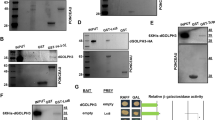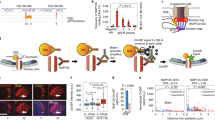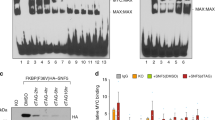Abstract
Myc proteins are powerful proto-oncoproteins and important promoters of growth and proliferation during normal development. They are thought to exercise their effects upon binding to their partner protein Max, and their activities are largely antagonized by complexes of Max with Mnt or an Mxd family protein. Although the biological functions of Myc, Mxd and Mnt have been intensively studied, comparatively little is known about the in vivo role of Max. Here we generate Max loss-of-function and reduction-of-function mutations in Drosophila melanogaster to address the contribution of Max to Myc-dependent growth control. We find that many biological activities of Myc do not, or only partly, require the association with Max—for example, the control of endoreplication and cell competition—and that a Myc mutant that does not interact with Max retains substantial biological activity. We further show that Myc can control RNA polymerase III independently of Max, which explains some of Myc's observed biological activities. These studies show the ability of Myc to function independently of Max in vivo and thus change the current model of Max network function.
This is a preview of subscription content, access via your institution
Access options
Subscribe to this journal
Receive 12 print issues and online access
$209.00 per year
only $17.42 per issue
Buy this article
- Purchase on Springer Link
- Instant access to full article PDF
Prices may be subject to local taxes which are calculated during checkout






Similar content being viewed by others
References
Vita, M. & Henriksson, M. The Myc oncoprotein as a therapeutic target for human cancer. Semin. Cancer Biol. 16, 318 (2006).
Dang, C.V. et al. The c-Myc target gene network. Semin. Cancer Biol. 16, 253 (2006).
Wanzel, M., Herold, S. & Eilers, M. Transcriptional repression by Myc. Trends Cell Biol. 13, 146–150 (2003).
Kretzner, L., Blackwood, E.M. & Eisenman, R.N. Myc and Max proteins possess distinct transcriptional activities. Nature 359, 426–429 (1992).
Amati, B. et al. Transcriptional activation by the human c-Myc oncoprotein in yeast requires interaction with Max. Nature 359, 423–426 (1992).
Facchini, L.M., Chen, S.J., Marhin, W.W., Lear, J.N. & Penn, L.Z. The Myc negative autoregulation mechanism requires Myc-Max association and involves the c-Myc P2 minimal promoter. Mol. Cell. Biol. 17, 100–114 (1997).
Mao, D.Y. et al. Analysis of Myc bound loci identified by CpG island arrays shows that Max is essential for Myc-dependent repression. Curr. Biol. 13, 882–886 (2003).
Amati, B. et al. Oncogenic activity of the c-Myc protein requires dimerization with Max. Cell 72, 233–245 (1993).
Amati, B., Littlewood, T.D., Evan, G.I. & Land, H. The c-Myc protein induces cell cycle progression and apoptosis through dimerization with Max. EMBO J. 12, 5083–5087 (1993).
Adhikary, S. & Eilers, M. Transcriptional regulation and transformation by Myc proteins. Nat. Rev. Mol. Cell Biol. 6, 635–645 (2005).
Hurlin, P.J. & Huang, J. The MAX-interacting transcription factor network. Semin. Cancer Biol. 16, 265 (2006).
Hurlin, P.J. et al. Deletion of Mnt leads to disrupted cell cycle control and tumorigenesis. EMBO J. 22, 4584–4596 (2003).
Nilsson, J.A. et al. Mnt loss triggers Myc transcription targets, proliferation, apoptosis, and transformation. Mol. Cell. Biol. 24, 1560–1569 (2004).
Shen-Li, H. et al. Essential role for Max in early embryonic growth and development. Genes Dev. 14, 17–22 (2000).
Gallant, P., Shiio, Y., Cheng, P.F., Parkhurst, S.M. & Eisenman, R.N. Myc and Max homologs in Drosophila. Science 274, 1523–1527 (1996).
Schreiber-Agus, N. et al. Drosophila Myc is oncogenic in mammalian cells and plays a role in the diminutive phenotype. Proc. Natl. Acad. Sci. USA 94, 1235–1240 (1997).
Johnston, L.A., Prober, D.A., Edgar, B.A., Eisenman, R.N. & Gallant, P. Drosophila myc regulates cellular growth during development. Cell 98, 779–790 (1999).
Pierce, S.B. et al. dMyc is required for larval growth and endoreplication in Drosophila. Development 131, 2317–2327 (2004).
Montero, L., Müller, N. & Gallant, P. Induction of apoptosis by Drosophila Myc. Genesis 46, 104–111 (2008).
De La Cova, C., Abril, M., Bellosta, P., Gallant, P. & Johnston, L.A. Drosophila myc regulates organ size by inducing cell competition. Cell 117, 107–116 (2004).
Moreno, E. & Basler, K. dMyc transforms cells into super-competitors. Cell 117, 117–129 (2004).
Gallant, P. Myc, cell competition, and compensatory proliferation. Cancer Res. 65, 6485–6487 (2005).
Trumpp, A. et al. c-Myc regulates mammalian body size by controlling cell number but not cell size. Nature 414, 768–773 (2001).
Benassayag, C. et al. Human c-Myc isoforms differentially regulate cell growth and apoptosis in Drosophila melanogaster. Mol. Cell. Biol. 25, 9897–9909 (2005).
Orian, A. et al. Genomic binding by the Drosophila Myc, Max, Mad/Mnt transcription factor network. Genes Dev. 17, 1101–1114 (2003).
Hulf, T. et al. Whole-genome analysis reveals a strong positional bias of conserved dMyc-dependent E-boxes. Mol. Cell. Biol. 25, 3401–3410 (2005).
Grandori, C. et al. c-Myc binds to human ribosomal DNA and stimulates transcription of rRNA genes by RNA polymerase I. Nat. Cell Biol. 7, 311–318 (2005).
Arabi, A. et al. c-Myc associates with ribosomal DNA and activates RNA polymerase I transcription. Nat. Cell Biol. 7, 303–310 (2005).
Grewal, S.S., Li, L., Orian, A., Eisenman, R.N. & Edgar, B.A. Myc-dependent regulation of ribosomal RNA synthesis during Drosophila development. Nat. Cell Biol. 7, 295–302 (2005).
Loo, L.W. et al. The transcriptional repressor dMnt is a regulator of growth in Drosophila melanogaster. Mol. Cell. Biol. 25, 7078–7091 (2005).
Gallant, P. Myc / Max / Mad in invertebrates - the evolution of the Max network. Curr. Top. Microbiol. Immunol. 302, 235–253 (2006).
Pierce, S.B. et al. Drosophila growth and development in the absence of dMyc and dMnt. Dev. Biol. 315, 303 (2008).
Maines, J.Z., Stevens, L.M., Tong, X. & Stein, D. Drosophila dMyc is required for ovary cell growth and endoreplication. Development 131, 775–786 (2004).
Blackwood, E.M. & Eisenman, R.N. Max: a helix-loop-helix zipper protein that forms a sequence-specific DNA-binding complex with Myc. Science 251, 1211–1217 (1991).
La Rocca, S.A., Crouch, D.H. & Gillespie, D.A. c-Myc inhibits myogenic differentiation and myoD expression by a mechanism which can be dissociated from cell transformation. Oncogene 9, 3499–3508 (1994).
Nair, S.K. & Burley, S.K. X-ray structures of Myc-Max and Mad-Max recognizing DNA. Molecular bases of regulation by proto-oncogenic transcription factors. Cell 112, 193–205 (2003).
Newsome, T.P., Asling, B. & Dickson, B.J. Analysis of Drosophila photoreceptor axon guidance in eye-specific mosaics. Development 127, 851–860 (2000).
Secombe, J., Li, L., Carlos, L. & Eisenman, R.N. The Trithorax group protein Lid is a trimethyl histone H3K4 demethylase required for dMyc-induced cell growth. Genes Dev. 21, 537–551 (2007).
Goodliffe, J.M., Wieschaus, E. & Cole, M.D. Polycomb mediates Myc autorepression and its transcriptional control of many loci in Drosophila. Genes Dev. 19, 2941–2946 (2005).
Gomez-Roman, N., Grandori, C., Eisenman, R.N. & White, R.J. Direct activation of RNA polymerase III transcription by c-Myc. Nature 421, 290–294 (2003).
Isogai, Y., Takada, S., Tjian, R. & Keles, S. Novel TRF1/BRF target genes revealed by genome-wide analysis of Drosophila Pol III transcription. EMBO J. 26, 79–89 (2007).
Bellosta, P. et al. Myc interacts genetically with Tip48/Reptin and Tip49/Pontin to control growth and proliferation during Drosophila development. Proc. Natl. Acad. Sci. USA 102, 11799–11804 (2005).
Wert, M., Kennedy, S., Palfrey, H.C. & Hay, N. Myc drives apoptosis in PC12 cells in the absence of Max. Oncogene 20, 3746–3750 (2001).
Cowling, V.H. & Cole, M.D. The Myc transactivation domain promotes global phosphorylation of the RNA polymerase II carboxy-terminal domain independently of direct DNA binding. Mol. Cell. Biol. 27, 2059–2073 (2007).
Kleine-Kohlbrecher, D., Adhikary, S. & Eilers, M. Mechanisms of transcriptional repression by Myc. Curr. Top. Microbiol. Immunol. 302, 51–62 (2006).
Bischof, J., Maeda, R.K., Hediger, M., Karch, F. & Basler, K. An optimized transgenesis system for Drosophila using germ-line-specific phiC31 integrases. Proc. Natl. Acad. Sci. USA 104, 3312–3317 (2007).
Stocker, H. et al. Rheb is an essential regulator of S6K in controlling cell growth in Drosophila. Nat. Cell Biol. 5, 559–565 (2003).
Takada, S., Lis, J.T., Zhou, S. & Tjian, R.A. TRF1:BRF complex directs Drosophila RNA polymerase III transcription. Cell 101, 459 (2000).
Prober, D.A. & Edgar, B.A. Growth regulation by oncogenes–new insights from model organisms. Curr. Opin. Genet. Dev. 11, 19–26 (2001).
Prober, D.A. & Edgar, B.A. Ras1 promotes cellular growth in the Drosophila wing. Cell 100, 435–446 (2000).
Acknowledgements
We thank S. Pierce and R. Eisenman (Fred Hutchinson Cancer Research Center) for providing us with a dm Mnt recombinant chromosome before publication; K. Basler, J. Bischof (University of Zürich), E. Hafen, H. Stocker (ETH Zürich), S. Takada (MD Anderson) and D. Stein (University of Texas, Austin) for flies and antibodies; H. Stocker and C. Hugentobler for advice; N. Müller, R. Perez and other members of the lab for technical help and support; O. Carreño, L. Damerius, N. Arnold, N. Meier and S. Peterhans for help with fly work; and K. Basler and R. Eisenman for critical comments on the manuscript. This work was financially supported by a grant from the Schweizerische Nationalfonds (SNF).
Author information
Authors and Affiliations
Corresponding author
Supplementary information
Supplementary Text and Figures
Supplementary Note, Supplementary Methods, Supplementary Figures 1–6, Supplementary Table 1 (PDF 3681 kb)
Rights and permissions
About this article
Cite this article
Steiger, D., Furrer, M., Schwinkendorf, D. et al. Max-independent functions of Myc in Drosophila melanogaster. Nat Genet 40, 1084–1091 (2008). https://doi.org/10.1038/ng.178
Received:
Accepted:
Published:
Issue Date:
DOI: https://doi.org/10.1038/ng.178
This article is cited by
-
Glycolytically impaired Drosophila glial cells fuel neural metabolism via β-oxidation
Nature Communications (2023)
-
Ordered structure induced in human c-Myc PEST region upon forming a disulphide bonded dimer
Journal of Chemical Sciences (2021)
-
The MYC transcription factor network: balancing metabolism, proliferation and oncogenesis
Frontiers of Medicine (2018)
-
Analysis of ZNF350/ZBRK1 promoter variants and breast cancer susceptibility in non-BRCA1/2 French Canadian breast cancer families
Journal of Human Genetics (2013)
-
Nutrient/TOR-dependent regulation of RNA polymerase III controls tissue and organismal growth inDrosophila
The EMBO Journal (2012)



